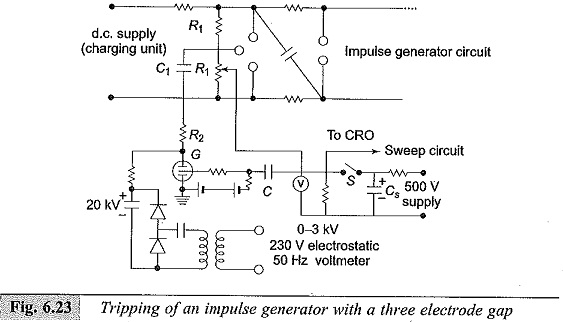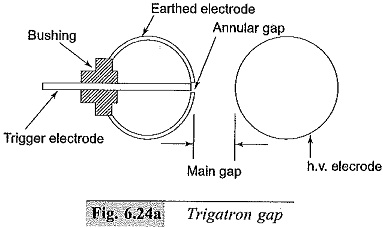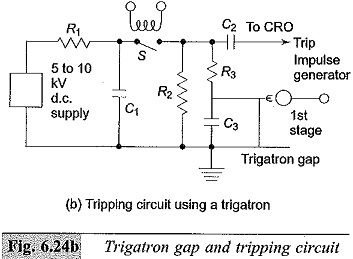Tripping of Impulse Generator:
In large impulse generator, the spark gaps are generally sphere gaps or gaps formed by hemispherical electrodes. The gaps are arranged such that sparking of one gap results in automatic sparking of other gaps as overvoltage is impressed on the other. In order to have consistency in sparking, irradiation from an ultraviolet lamp is provided from the bottom to all the gaps.
To trip the generator at a predetermined time, the spark gaps may be mounted on a movable frame, and the gap distance is reduced by moving the movable electrodes closer. This method is difficult and does not assure consistent and control led tripping.
A simple method of controlled tripping consists of making the first gap a three electrode gap and firing it from a controlled source. Figure 6.23 gives the schematic arrangement of a three electrode gap. The first stage of the impulse generator is fitted with a three electrode gap, and the central electrode is maintained at a potential in between that of the top and the bottom electrodes with the resistors R1 and R1.
The tripping is initiated by applying a pulse to the thyratron G by closing the switch S. The capacitor C produces an exponentially decaying pulse of positive polarity. The pulse goes and initiates the oscilloscope time base. The thyratron conducts on receiving the pulse from the switch S and produces a negative pulse through the capacitance C1 at the central electrode of the three electrode gap. Hence, the voltage between the central electrode and the top electrode of the three electrode gap goes above its sparking potential and thus the gap conducts.
The time lag required for the thyratron firing and breakdown of the three electrode gap ensures that the sweep circuit of the oscilloscope begins before the start of the impulse generator voltage. The resistance R2 ensures decoupling of voltage oscillations produced at the spark gap entering the oscilloscope through the common trip circuit.
The three electrode gap requires larger space and an elaborate construction. Nowadays a trigatron gap shown in Fig. 6.24 is used, and this requires much smaller voltage for operation compared to the three electrode gap. A trigatron gap consists of a high voltage spherical electrode of suitable size, an earthed main electrode of spherical shape, and a trigger electrode through the main electrode. The trigger electrode is a metal rod with an annular clearance of about 1mm fitted into the main electrode trough a bushing.
The trigatron is connected to a pulse circuit as shown in Fig. 6:24b. Tripping of the impulse generator is effected by a trip pulse which produces a spark between the trigger electrode and the earthed sphere. Due to space charge effects and distortion of the field in the main gap, sparkover of the main gap occurs. The trigatron gap is polarity sensitive and a proper polarity pulse should be applied for correct operation.


